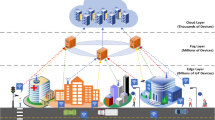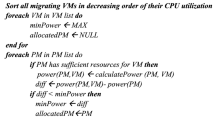Abstract
Recently, with the expansion of communications and generated data, the need for processing this high volume of data in minimum time and maximum speed has increased. Also, performing this volume of computing operations requires high processing and storage resources leading to hardware cost increment. In such systems, one of the most critical challenges is the task scheduling problem, which tries to find the optimal allocation for maximum resource usage and reduce the response time. Therefore, the purpose of this study is to design an infrastructure for smart home energy management with minimum hardware cost using cloud and fog computing and to propose a latency-aware scheduling algorithm based on virtual machine matching using meta-heuristics. Among heuristic methods, Tabu search makes it a common practice because of its high expansion in various optimization issues, as well as memory and high-speed features. Thereby, a novel algorithm based on the Tabu search is proposed that is improved using approximate nearest neighbor (ANN) and fruit fly optimization (FOA) algorithms. Finally, to validate the proposed method, a case study is simulated and the proposed algorithm is implemented considering target factors of execution time, latency, allocated memory, and cost function to illustrate the performance of the algorithm. The comparison results show that the proposed algorithm outperforms the Tabu search, genetic algorithm, PSO, and simulated annealing methods.








Similar content being viewed by others
References
Varghese B, Buyya R (2018) Next generation cloud computing: New trends and research directions. Future Gener Comput Syst 79:849–861. https://doi.org/10.1016/J.FUTURE.2017.09.020
Amadeo M, Giordano A, Mastroianni C, Molinaro A (2019) On the integration of information centric networking and fog computing for smart home services. Springer, Cham, pp 75–93
Rahmani AM, Gia TN, Negash B, Anzanpour A, Azimi I, Jiang M, Liljeberg P (2018) Exploiting smart e-Health gateways at the edge of healthcare Internet-of-Things: a fog computing approach. Future Gener Comput Syst 78:641–658. https://doi.org/10.1016/J.FUTURE.2017.02.014
Gilbert GM, Naiman S, Kimaro H, Bagile B (2019) A critical review of edge and fog computing for smart grid applications. Springer, Berlin
Wang P, Liu S, Ye F, Chen X (2018) A fog-based architecture and programming model for IoT applications in the smart grid.
Hussain M, Beg MM (2019) Fog Computing for Internet of Things (IoT)-aided smart grid architectures. Big Data Cogn Comput 3(1):8. https://doi.org/10.3390/bdcc3010008
Dowsland KA, Thompson JM (2012) Simulated annealing BT—handbook of natural computing. In Rozenberg G, Bäck T, Kok JN (eds). Springer, Berlin, pp. 1623–1655
Zhang H, Shi J, Deng B, Jia G, Han G, Shu L (2019) MCTE: Minimizes task completion time and execution cost to optimize scheduling performance for smart grid cloud. IEEE Access 7:134793–134803. https://doi.org/10.1109/ACCESS.2019.2942067
Sun H, Yu H, Fan G, Chen L (2020) Energy and time efficient task offloading and resource allocation on the generic IoT-fog-cloud architecture. Peer-to-Peer Netw Appl 13(2):548–563. https://doi.org/10.1007/s12083-019-00783-7
Li J, Han Y (2020) A hybrid multi-objective artificial bee colony algorithm for flexible task scheduling problems in cloud computing system. Cluster Comput 23(4):2483–2499. https://doi.org/10.1007/s10586-019-03022-z
Tang H, Li C, Bai J, Tang JH, Luo Y (2019) Dynamic resource allocation strategy for latency-critical and computation-intensive applications in cloud–edge environment. Comput Commun 134:70–82. https://doi.org/10.1016/j.comcom.2018.11.011
Eng KL, Muhammed A, Mohamed MA, Hasan S (2020) A hybrid heuristic of variable neighbourhood descent and great deluge algorithm for efficient task scheduling in Grid computing. Eur J Oper Res 284(1):75–86. https://doi.org/10.1016/j.ejor.2019.12.006
Sanaj MS, Joe Prathap PM (2020) Nature inspired chaotic squirrel search algorithm (CSSA) for multi objective task scheduling in an IAAS cloud computing atmosphere. Eng Sci Technol Int J 23(4):891–902. https://doi.org/10.1016/j.jestch.2019.11.002
Pirim H, Bayraktar E, Eksioglu B (2008) Tabu search: a comparative study. Tabu Search. https://doi.org/10.5772/5637
Glover F (1995) Tabu search fundamentals and uses. Vasa
Ashtiani AF, Pierre S, Feizi A, Pierre S (2020) Power allocation and resource assignment for secure D2D communication underlaying cellular networks: a Tabu search approach. Comput Netw 178:107350. https://doi.org/10.1016/j.comnet.2020.107350
Alharkan I, Saleh M, Ghaleb MA, Kaid H, Farhan A, Almarfadi A (2020) Tabu search and particle swarm optimization algorithms for two identical parallel machines scheduling problem with a single server. J King Saud Univers Sci 32(5):330–338. https://doi.org/10.1016/j.jksues.2019.03.006
Mathlouthi I, Gendreau M, Potvin JY (2021) A metaheuristic based on tabu search for solving a technician routing and scheduling problem. Comput Oper Res 125:105. https://doi.org/10.1016/j.cor.2020.105079
Memari P, Tavakkoli-Moghaddam R, Navazi F, Jolai F (2020) Air and ground ambulance location-allocation-routing problem for designing a temporary emergency management system after a disaster. Proc Inst Mech Eng Part H J Eng Med 234(8):812–828. https://doi.org/10.1177/0954411920925207
Arostegui MA, Kadipasaoglu SN, Khumawala BM (2006) An empirical comparison of Tabu search, simulated annealing, and genetic algorithms for facilities location problems. Int J Prod Econ 103:742–754. https://doi.org/10.1016/j.ijpe.2005.08.010
Chu B (1999) Genetic Algorithms vs. Tabu search in timetable scheduling, pp 492–495
Rathore MM, Paul A, Hong W-H, Seo H, Awan I, Saeed S (2018) Exploiting IoT and big data analytics: defining Smart Digital City using real-time urban data. Sustain Cities Soc 40:600–610. https://doi.org/10.1016/J.SCS.2017.12.022
Bitam S, Zeadally S, Mellouk A (2018) Fog computing job scheduling optimization based on bees swarm. Enterp Inf Syst 12(4):373–397. https://doi.org/10.1080/17517575.2017.1304579
Li C, Liu J, Li W, Luo Y (2021) Adaptive priority-based data placement and multi-task scheduling in geo-distributed cloud systems. Knowl Based Syst 224:107050. https://doi.org/10.1016/j.knosys.2021.107050
Peng L, Dhaini AR, Ho P-H (2018) Toward integrated Cloud–Fog networks for efficient IoT provisioning: key challenges and solutions. Future Gener Comput Syst 88:606–613. https://doi.org/10.1016/J.FUTURE.2018.05.015
Yassine A, Singh S, Hossain MS, Muhammad G (2019) IoT big data analytics for smart homes with fog and cloud computing. Future Gener Comput Syst 91:563–573. https://doi.org/10.1016/J.FUTURE.2018.08.040
Naqvi SAA, Javaid N, Butt H, Kamal MB, Hamza A, Kashif M (2019) Metaheuristic optimization technique for load balancing in cloud-fog environment integrated with smart grid. Springer, Cham, pp 700–711
Naranjo PGV, Pooranian Z, Shojafar M, Conti M, Buyya R (2018) FOCAN: a Fog-supported smart city network architecture for management of applications in the Internet of Everything environments. J Parallel Distrib Comput. https://doi.org/10.1016/J.JPDC.2018.07.003
Iwanir E, Tamir T (2019) Recent advances in computational optimization, 795 207 233https://doi.org/10.1007/978-3-319-99648-6
Wang B, Wang C, Huang W, Song Y, Qin X (2021) Security-aware task scheduling with deadline constraints on heterogeneous hybrid clouds. J Parallel Distrib Comput 15:315–28. https://doi.org/10.1016/j.jpdc.2021.03.003
Bittencourt L, Immich R, Sakellariou R, Fonseca N, Madeira E, Curado M, Villas L, DaSilva L, Lee C, Rana O (2018) The Internet of Things, Fog and Cloud continuum: integration and challenges. Internet Things 3:4134–155. https://doi.org/10.1016/J.IOT.2018.09.005
Pérez JL, Gutierrez-Torre A, Berral JL, Carrera D (2018) A resilient and distributed near real-time traffic forecasting application for Fog computing environments. Future Gener Comput Syst 87:198–212. https://doi.org/10.1016/J.FUTURE.2018.05.013
Lin K, Pankaj S, Wang D (2018) Task offloading and resource allocation for edge-of-things computing on smart healthcare systems. Comput Electr Eng 72:348–360. https://doi.org/10.1016/J.COMPELECENG.2018.10.003
Basu S, Karuppiah M, Selvakumar K, Li KC, Islam SH, Hassan MM, Bhuiyan MZ (2018) An intelligent/cognitive model of task scheduling for IoT applications in cloud computing environment. Future Gener Comput Syst 88:254–261. https://doi.org/10.1016/j.future.2018.05.056
Li Q, Zhao L, Gao J, Liang H, Zhao L, Tang X (2018) SMDP-based coordinated virtual machine allocations in cloud-fog computing systems. IEEE Internet Things J 5(3):1977–1988. https://doi.org/10.1109/JIOT.2018.2818680
Hussain M, Wei LF, Lakhan A, Wali S, Ali S, Hussain A (2021) Energy and performance-efficient task scheduling in heterogeneous virtualized cloud computing. Sustain Comput Inform Syst 30:100517. https://doi.org/10.1016/j.suscom.2021.100517
Mohammad Hasani Zade B, Mansouri N, Javidi MM (2021) SAEA: A security-aware and energy-aware task scheduling strategy by Parallel Squirrel Search Algorithm in cloud environment. Expert Syst Appl 176:114915. https://doi.org/10.1016/j.eswa.2021.114915
Memari P, Mohammadi SS, Ghaderi SF (2018) Data mining model for evaluating and forecasting energy consumption by cloud computing. In: 2018 IEEE electrical power and energy conference (EPEC), pp 1–6. https://doi.org/10.1109/EPEC.2018.8598381.
Thevenin S, Zufferey N (2018) Learning variable neighborhood search for a scheduling problem with time windows and rejections. Discrete Appl Math. https://doi.org/10.1016/J.DAM.2018.03.019
Pacheco J, Porras S, Casado S, Baruque B (2018) Variable neighborhood search with memory for a single-machine scheduling problem with periodic maintenance and sequence-dependent set-up times. Knowl Based Syst 145:236–249. https://doi.org/10.1016/J.KNOSYS.2018.01.018
Zeng Z, Yu X, He K, Fu Z (2018) Adaptive Tabu search and variable neighborhood descent for packing unequal circles into a square. Appl Soft Comput 65:196–213. https://doi.org/10.1016/J.ASOC.2017.11.051
Mathlouti I, Gendreau M, Potvin J-Y (2018) A metaheuristic based on tabu search for solving a technician routing and scheduling problem. Comput Oper Res. https://doi.org/10.1103/PhysRevLett.96.028305
Houssein EH, Gad AG, Wazery YM, Suganthan PN (2021) Task scheduling in cloud computing based on meta-heuristics: review, taxonomy, open challenges, and future trends. Swarm Evol Comput 62:100841. https://doi.org/10.1016/j.swevo.2021.100841
Sharifi AH, Maghouli P (2019) Energy management of smart homes equipped with energy storage systems considering the PAR index based on real-time pricing. Sustain Cities Soc 45:579–587. https://doi.org/10.1016/j.scs.2018.12.019
Iqbal A, Ullah F, Anwar H, Kwak KS, Imran M, Jamal W, ur Rahman A (2018) Interoperable Internet-of-Things platform for smart home system using web-of-objects and cloud. Sustain Cities Soc 38:636–646. https://doi.org/10.1016/j.scs.2018.01.044
Alboaneen D, Tianfield H, Zhang Y, Pranggono B (2021) A metaheuristic method for joint task scheduling and virtual machine placement in cloud data centers. Future Gener Comput Syst 115:201–212. https://doi.org/10.1016/j.future.2020.08.036
Sattarpour T, Nazarpour D, Golshannavaz S (2018) A multi-objective HEM strategy for smart home energy scheduling: a collaborative approach to support microgrid operation. Sustain Cities Soc. https://doi.org/10.1016/j.scs.2017.09.037
Alsaidy SA, Abbood AD, Sahib MA (2020) Heuristic initialization of PSO task scheduling algorithm in cloud computing. J King Saud Univers Comput Inf Sci. https://doi.org/10.1016/j.jksuci.2020.11.002
Memari P, Mohammadi SS, Ghaderi SF (2018) Cloud platform real-time measurement and verification procedure for energy efficiency of washing machines. https://doi.org/10.15439/2018F35
Raidl GR, Puchinger J, Blum C. Metaheuristic hybrids
Puchinger J, Raidl R (2005) Artificial intelligence and knowledge engineering applications: a bioinspired approach. 3562:41–53https://doi.org/10.1007/b137296
Ling KQ (1996) Photochemical synthesis of l, 2-dihydro-3H-indol-3-ones. Chem Res Chin Univers 17(6):268–308. https://doi.org/10.1007/s10479-005-3971-7
Glover F (1989) Tabu search—Part I. ORSA J Comput 1(3):190–206. https://doi.org/10.1287/ijoc.1.3.190
Yadwadkar NJ, Hariharan B, Gonzalez JE, Katz R (2016) Multi-task learning for straggler avoiding predictive job scheduling. J Mach Learn Res, pp 171–37
Indyk P, Motwani R (1998) Approximate nearest neighbors, pp 604–613. https://doi.org/10.1145/276698.276876.
Pan W-T (2012) A new fruit fly optimization algorithm: taking the financial distress model as an example. Knowl Based Syst. https://doi.org/10.1016/J.KNOSYS.2011.07.001
Author information
Authors and Affiliations
Corresponding author
Additional information
Publisher's Note
Springer Nature remains neutral with regard to jurisdictional claims in published maps and institutional affiliations.
Rights and permissions
About this article
Cite this article
Memari, P., Mohammadi, S.S., Jolai, F. et al. A latency-aware task scheduling algorithm for allocating virtual machines in a cost-effective and time-sensitive fog-cloud architecture. J Supercomput 78, 93–122 (2022). https://doi.org/10.1007/s11227-021-03868-4
Accepted:
Published:
Issue Date:
DOI: https://doi.org/10.1007/s11227-021-03868-4




